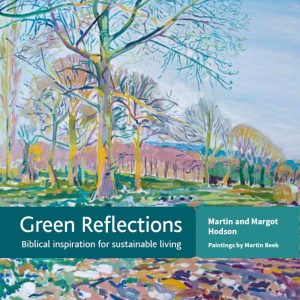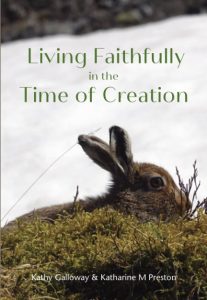| Anglican lectionary: Catholic lectionary: | 1st Reading Dan 12:1-3 both | Psalm 16 – | 2nd Reading Hebr 10:11-25 both | Gospel Mark 13:1-8 Mark 13:24-32 |
by Dr Martin J Hodson, Operations Director for the John Ray Initiative, Oxford, United Kingdom
NOTES ON THE READINGS
OLD TESTAMENT Daniel 12:1-3
The Archangel Michael is only mentioned in the Book of Daniel in the Old Testament, and later in Jude and Revelation in the New Testament. He is seen as a fairly warlike character, and as a protector of the Jewish people. The passage is complex and is full of eschatological allusions. It points to a time of distress, but that leads to deliverance and resurrection. It is probably the clearest example of a passage indicating that some people will undergo resurrection after death in the Old Testament. This will also be a time of judgement where some will be granted everlasting life and others will be put to shame. The wise will lead the people into righteousness.
Psalm 16
Psalm 16 is attributed to David, and it is one of six denoted as a Miktam, most probably Psalms of atonement. The first part of the Psalm is an affirmation of faith in God. But it is clear that those who worship other Gods will not be blessed and will suffer. In the second section we see that those who are in communion with God have a “delightful inheritance”. The last part sees the psalmist rejoicing and hopeful.
EPISTLE Hebrews 10:11-14 (15-18), 19-25
This passage contrasts the priests in the Temple in Jerusalem, who made continual sacrifices, with Jesus. The sacrifices made by the priests could never take away sins. But Jesus was both a priest and a sacrifice. His sacrifice of himself, made once and for all, took away the sins of those who turned to him. The writer of Hebrews quotes Jeremiah 31:33 in describing a new covenant where laws will be put on hearts and written in minds. Sacrifices will no longer be needed. Previously, only the high priests could enter the Most Holy Place, and then only on the Day of Atonement. After Jesus’ perfect sacrifice of himself all would be able to enter.
The later section of the passage encourages people to hold to their faith, and to love and care for each other. The believers are encouraged to keep meeting together, and not to stop as some had. Finally, right at the end of our passage we see a clear mention of the Second Coming, “the Day approaching”.
GOSPEL Mark 13:1-8
In Mark 13 Jesus is with the disciples in Herod the Great’s restored Second Temple in Jerusalem. It was one of the wonders of the ancient world, and it is hardly surprising that the disciples were amazed by what they saw. Jesus came from a particularly devout family, and had probably visited very often in his childhood. He shocked the disciples when he prophesied that the Temple would be destroyed. This came true about 40 years later, in 70 AD, when the Romans put down a Jewish uprising. Not unnaturally, the disciples wanted to know when this would happen, and how they would know it was about to happen. Now we come to the key problem of the passage. It seems that Jesus then goes off at a tangent. He appears not to answer the disciples question at all, says nothing about the destruction of the Temple, and commences a discourse about the Second Coming. So we have warnings about false prophets, wars, earthquakes, and famines leading on to Mark 13:26 when the Son of Man comes on clouds. See Wright (References below) for a detailed possible explanation of why it can look like Jesus did not answer the disciples’ question, but possibly he did!
DRAFT SERMON/SERMON OUTLINE
This sermon will be preached as COP26 ends, and delegates are making their way home. These will include Michael Rentz, the coordinator of Sustainable Preaching, who took part in a discussion on “new forms of dialogues needed facing climate change” (see Resources below).
It might be good to start the sermon by summarising COP26- just the headlines! Whether COP26 is seen as good, bad or in between, there will still be a future, and three of our readings have some references to the future.
As Christians in more liturgical traditions, we will often say the Apostles’ Creed, including the phrase, “he will come again to judge the living and the dead.” But possibly because of the extreme theologies that are often associated with it, eschatology has a bad name. Rightly understood, however, eschatology is a key part of our faith, and is important in environmental theology. Moreover, future judgment is frequently seen within these eschatological schemes.
Our passage from Daniel indicates that there will be a time of judgment in the future. At COP26 there were leaders of nations and organisations present who sought to prevent meaningful cuts in carbon emissions, to further their own ends. There were also those who worked so hard to do something to reverse climate change that they are now totally exhausted. Which of these will have “shame and everlasting contempt?” This is not to say that any of us are free from sin, but those who wilfully put human lives and the future of the world’s biodiversity at risk should not benefit from doing so.
Mark 13 contains within it a passage often known as the “little apocalypse”, where many people see Jesus returning at the end of the age, coming on a cloud. When He returns, Heaven and Earth will be renewed and restored. This is ultimate or eschatological hope, and it has sustained Christians for 2000 years. At COP26 most of the hope will not have been like that. Mostly the hope will be proximate, the hope that we can fix climate change. But what if we can’t fix it, and we still don’t know when Jesus will return? Twelve years ago, after the disastrous COP15 meeting in Copenhagen, I was involved in a project to look at hope in those circumstances (see References below). We discovered a robust or resilient hope, a hope to see us through tough times. Whatever the result of COP26 in Glasgow things are likely to be pretty difficult this century, and looking again at hope might be a fruitful way forward.
Near the end of the sermon I would suggest some resources for people as they reflect on COP26 (see below).
ADDITIONAL MATERIAL
References
Hodson, M.J. (2021) Three types of hope. Bible Reading Fellowship blog (4 July 2021) https://www.brf.org.uk/three-types-of-hope/ This is written at a more popular level and is the story of our “Environment and Hope” project brought up to date.
Hodson M.R. & Hodson, M.J. (2013) Environment and Hope. Anvil 29, Issue 1, pp.1-129. https://jri.org.uk/environment-and-hope/ From this link you can download all of the seven articles for free.
Lacocque, A. (2018) The Book of Daniel. Cascade Books, Eugene, Oregon, Kindle Edition. 2nd ed. (Chapter 12, Resurrection and Eschatology). This is a very detailed and up to date commentary- some knowledge of Hebrew would be useful.
Wright, N.T. (1996) Jesus and the Victory of God. (SPCK, London) See pages 339-368 for a detailed discussion of Mark 13 and the parallel passages in Matthew and Luke.
Resources
The Institute for Advanced Sustainability Studies (IASS). Michael Rentz, the coordinator of Sustainable Preaching, will have been involved in a discussion on “new forms of dialogues needed facing climate change” at COP26 in Glasgow on the 10th November. Can we change our language of the way we relate to the world to include reconciliation and healing in the way the Bible teaches us? A description of the work including a video from Carolin Fraude can be found here: https://www.iass-potsdam.de/en/events/iass-at-COP26
 Hodson, M.J. & Hodson M.R. (2021) Green Reflections: Biblical inspiration for sustainable living (BRF, Abingdon). This has 62 short Bible reflections on environmental topics and is suitable for individual use, or some of the reflections could be useful for services or day conferences etc.
Hodson, M.J. & Hodson M.R. (2021) Green Reflections: Biblical inspiration for sustainable living (BRF, Abingdon). This has 62 short Bible reflections on environmental topics and is suitable for individual use, or some of the reflections could be useful for services or day conferences etc.
The Big Church Read goes Green! How do we respond to COP26? The Big Church Read is a UK national initiative to encourage groups, individuals and churches to read and discuss Christian books. Join Martin & Margot Hodson as they lead us through A Christian Guide to Environmental Issues (BRF, 2021). They explain the key current environmental problems and provide a biblical basis for caring for the environment, with practical ways to respond. Presented over 10 sessions with accompanying videos and questions for reflection and discussion. Sign up for free to receive the reading plan and all you need to take part. https://thebigchurchread.co.uk/a-christian-guide-to-environmental-issues-2/
 Galloway, K. & Preston, K.M. eds. (2021) Living Faithfully in the Time of Creation. Wild Goose Publications, Glasgow. For celebrating Creationtide mindfully in an age of environmental emergency, resources from the Iona Community’s Common Concern Network on the Environment.
Galloway, K. & Preston, K.M. eds. (2021) Living Faithfully in the Time of Creation. Wild Goose Publications, Glasgow. For celebrating Creationtide mindfully in an age of environmental emergency, resources from the Iona Community’s Common Concern Network on the Environment.
by Dr Martin J Hodson, UK
 Erasmus+ – project
Erasmus+ – project